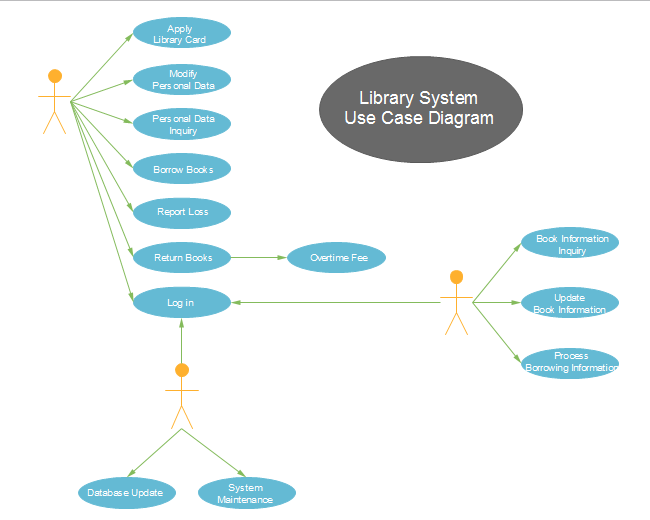

Every book will have ISBN, Title, Subject, Publishers, etc.
 Book: The basic building block of the system. It has attributes like ‘Name’ to distinguish it from any other libraries and ‘Address’ to describe its location.
Book: The basic building block of the system. It has attributes like ‘Name’ to distinguish it from any other libraries and ‘Address’ to describe its location. #Use case diagram for library management system software#
Library: The central part of the organization for which this software has been designed.Here are the main classes of our Library Management System: Use Case Diagram for Library Management System Here is the use case diagram of our Library Management System: Return a book: To return a book to the library which was issued to a member.Renew a book: To reborrow an already checked-out book.Reserve book: To reserve a book which is not currently available.Check-out book: To borrow a book from the library.Register new account/cancel membership: To add a new member or cancel the membership of an existing member.Search catalog: To search books by title, author, subject or publication date.Add/Remove/Edit book: To add, remove or modify a book or book item.

Here are the top use cases of the Library Management System:
System: Mainly responsible for sending notifications for overdue books, canceled reservations, etc. Member: All members can search the catalog, as well as check-out, reserve, renew, and return a book. The Librarian can also issue, reserve, and return book items. Librarian: Mainly responsible for adding and modifying books, book items, and users. The system will be able to read barcodes from books and members’ library cards. Each book and member card will have a unique barcode. The system should be able to send notifications whenever the reserved books become available, as well as when the book is not returned within the due date. Members should be able to reserve books that are not currently available. The system should be able to collect fines for books returned after the due date. There should be a maximum limit (10) on how many days a member can keep a book. There should be a maximum limit (5) on how many books a member can check-out. The system should be able to retrieve information like who took a particular book or what are the books checked-out by a specific library member. We will call each copy of a book, a book item. There could be more than one copy of a book, and library members should be able to check-out and reserve any copy. Each book will have a unique identification number and other details including a rack number which will help to physically locate the book. Any library member should be able to search books by their title, author, subject category as well by the publication date. We will focus on the following set of requirements while designing the Library Management System: Be sure to ask questions to find the exact scope of the system that the interviewer has in mind. Library management systems also involve maintaining the database for entering new books and recording books that have been borrowed with their respective due dates.Īlways clarify requirements at the beginning of the interview. 
Library management systems help libraries keep track of the books and their checkouts, as well as members’ subscriptions and profiles. Libraries rely on library management systems to manage asset collections as well as relationships with their members. Design a Library Management System Let's design a Library Management SystemĪ Library Management System is a software built to handle the primary housekeeping functions of a library.







 0 kommentar(er)
0 kommentar(er)
